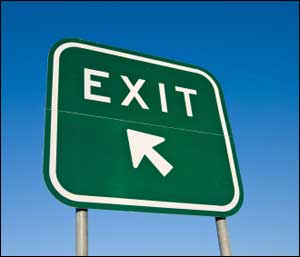 Back in October, we started the Analytics Focus series focusing on various web metrics and how they are used. At that time, I wrote about a very important and useful metric: Bounce Rate. But today, I’m looking at another metric that is often confused with that one, and also often given more importance (although it should not be): Exit Rate.
Back in October, we started the Analytics Focus series focusing on various web metrics and how they are used. At that time, I wrote about a very important and useful metric: Bounce Rate. But today, I’m looking at another metric that is often confused with that one, and also often given more importance (although it should not be): Exit Rate.
What Is Exit Rate?
Simply put, a page’s Exit Rate is the number of times where that page was the last page viewed in a session, divided by the total page views for that page.
Every visitor’s session comes to an end sometime, whether that visitor looked at one, ten, or fifty pages. Whatever page was viewed last in the session is the “exit page”. The number of times that page was the “exit page” divided by the total number of times that page was viewed is the Exit Rate for that page.
How Does Exit Rate Differ From Bounce Rate?
If you recall, Bounce Rate is the percentage of sessions that contain only one page view. Any one-page visitor session is called a “Bounce”. The number of Bounces divided by the total number of sessions is the Bounce Rate. For a given page, Bounce rate is calculated as the number of Bounces from that page, divided by the number of sessions that began on that page.
As I said, every session has to end sometime. Every session has an exit page—the last page viewed in the session. But not all sessions result in bounces. The fewer the better in fact. The Bounce Rate is a good indicator whether a site is doing a good job of delivering what visitors are expecting, and the Bounce Rate for an individual page can indicate if that page is doing its job of enticing the visitor to take action or read more. The Exit Rate simply tells you which pages were most often the final page in a session. This sounds like it should be pretty useful, but is it?
So What Does Exit Rate Do For Me?
How useful is Exit Rate? Well, not all that useful in my opinion. In the beginning, the Exit Rate supposedly gave you an indication of “leakage”—what pages were causing people to fall off the site. But it’s what they did before they exited that is important! If you have an ecommerce site and they made a purchase, then your site accomplished what you wanted. That they exited from a given page is rather unimportant.
So you might say, “But Tom, then they should be exiting from the Thank You page. Other pages with high exit rates are a bigger concern.” Possibly, but if they made a purchase, and then clicked on just one more page to review something, perhaps the shipping page to see what carrier will be used, and then left, is that saying something bad about the shipping page? Absolutely not! The site did its job very well.
If someone in research mode came and looked at six different products you offer and then left, is the product page for that last product they looked at underperforming? Of course not. If someone actually adds something to the cart but plans to come back tomorrow to finish the order for some reason, does the Exit from the Cart page indicate a problem? Certainly not. In all these cases, the site is doing what you want it to do.
Whereas Bounces point to a specific problem (user entered site, user was unimpressed, user left without doing anything), Exits tell you nothing without knowing what happened in the session prior to the exit.
So as a rule of thumb, don’t get too hung up on Exit Rate.
Exceptions
What would a rule of thumb be without exceptions? There are some pages that you definitely prefer not to have any exits from. If you have a three step checkout process, once the user starts the process, you definitely want them to finish. So high exit rates on steps one and two can possibly be things to explore. But even then, it helps to know if those visits eventually led to completed orders or not.
For sites with a Site Search function, I like to have a low exit rate on the Search page. A high exit rate means that they searched, didn’t see anything in the results that enticed them to click, so the left. A high exit rate on your Search Results page can be an indicator of a problem with your search function.
I’m sure there are other exceptions, but even in these cases, if you’re seeing a high exit rate and think you have reason to be concerned, I’d recommend that you take the steps to be able to review those sessions in more detail before drawing any conclusions about your perceived problems.







